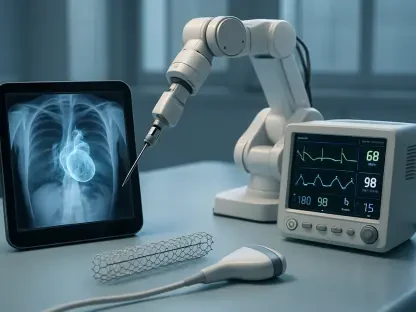The in vitro diagnostics (IVD) industry is undergoing a profound transformation, driven by a surge in mergers and acquisitions that are reshaping the competitive landscape in ways that could redefine healthcare innovation for years to come. With major players making bold strategic moves, the sector is witnessing unprecedented consolidation, fueled by the pursuit of technological advancements like AI-driven genomics and the allure of stable revenue streams. Companies are either doubling down on cutting-edge areas such as precision medicine or divesting non-core assets to sharpen their focus. This dynamic environment is not only altering market power but also raising questions about the future of competition and accessibility in diagnostics. As private equity firms and industry giants navigate this evolving terrain, the implications for laboratory leaders and healthcare providers are becoming increasingly significant, setting the stage for a deeper exploration of these pivotal shifts.
Strategic Consolidations Reshaping the Industry
QIAGEN’s Leap into Data-Driven Innovation
A striking example of the IVD sector’s transformation is QIAGEN’s acquisition of Parse Biosciences for up to $280 million, a move that underscores a strategic pivot toward data-rich technologies. This deal brings Parse’s Evercode platform and single-cell sequencing capabilities into QIAGEN’s portfolio, positioning the company as a leader in AI-driven drug discovery and predictive biology. The integration of such advanced tools reflects a broader industry trend where data analytics is becoming a critical competitive edge. Beyond mere expansion, this acquisition signals a shift away from traditional instrument-based models to scalable, data-centric approaches that promise to revolutionize how diagnostics inform personalized medicine. The focus on harnessing vast datasets to predict biological outcomes could redefine research and clinical applications, potentially accelerating the development of targeted therapies.
Furthermore, QIAGEN’s bold step highlights the growing importance of precision in diagnostics, where understanding individual cellular behavior can unlock new frontiers in treatment. This acquisition is not just about acquiring technology but also about building a foundation for future innovation that aligns with the industry’s push toward tailored healthcare solutions. As companies like QIAGEN prioritize such advancements, the ripple effects are likely to influence supply chains and vendor relationships, compelling smaller players to adapt or risk obsolescence. The challenge lies in balancing these cutting-edge pursuits with accessibility, ensuring that the benefits of such technologies reach a broad spectrum of healthcare providers and patients without exacerbating existing disparities in the market.
Hologic’s Private Equity Backing and Market Confidence
Another transformative deal reshaping the IVD landscape is Hologic’s staggering $18.3 billion buyout by private equity giants Blackstone and TPG, a transaction that speaks volumes about investor confidence in diagnostics. Particularly strong in women’s health, Hologic’s steady revenue streams have made it an attractive target for firms seeking stable, cash-generating platforms amid economic uncertainty. This move by private equity underscores a growing trend where financial players are increasingly drawn to healthcare sectors that promise resilience and consistent returns. The infusion of capital and strategic oversight from such investors could propel Hologic to expand its reach, potentially enhancing its ability to innovate within specialized diagnostic niches.
Additionally, the involvement of private equity in deals like Hologic’s suggests a broader reshaping of industry priorities, where financial stability often takes precedence alongside technological progress. This transaction may encourage other IVD companies to seek similar partnerships, creating a domino effect of consolidation that could concentrate market power among fewer entities. While this offers opportunities for operational efficiency and scaled innovation, it also raises concerns about reduced competition and potential price pressures for end-users. As private equity continues to shape the sector, the long-term impact on diagnostic affordability and access remains a critical point of observation for industry stakeholders.
Technological and Financial Trends Driving Change
Siemens Healthineers’ Strategic Repositioning
Siemens Healthineers is making waves with its potential $7 billion divestiture of its diagnostics division, a decision that reflects a calculated shift toward imaging and oncology as core focus areas. This strategic repositioning illustrates how even industry giants are reevaluating their portfolios to align with emerging healthcare demands and technological frontiers. By shedding non-core assets, Siemens aims to streamline operations and invest more heavily in areas poised for growth, signaling a trend of specialization over broad diversification. Such moves could redefine competitive dynamics, as divested assets often attract new players or private equity interest, further fueling the consolidation wave.
Moreover, Siemens’ decision highlights the delicate balance between maintaining a wide market presence and honing expertise in high-growth sectors. The potential sale has drawn attention from firms like Blackstone and KKR, indicating strong investor appetite for diagnostics despite the sector’s challenges. This divestiture could reshape vendor landscapes for laboratories, as new ownership might bring changes in pricing, support, or product focus. As Siemens redirects its resources, the industry watches closely to see whether this specialization will inspire similar restructurings among other major players, potentially accelerating the trend of focused innovation over the next few years.
AI and Data Analytics as Competitive Cornerstones
Technological innovation, particularly in AI and data analytics, is rapidly becoming a cornerstone of competitive advantage in the IVD market, as evidenced by strategic moves from leading companies. The emphasis on integrating AI into diagnostics is transforming how data is leveraged, moving beyond traditional testing to predictive and personalized healthcare solutions. Companies are investing heavily in platforms that can analyze complex datasets, enabling faster and more accurate diagnoses that could ultimately improve patient outcomes. This shift toward data-driven models is not merely a trend but a fundamental change in how diagnostics contribute to broader medical advancements.
Equally significant is the potential for AI to streamline operational efficiencies within the IVD sector, reducing costs and enhancing scalability for companies adopting these technologies. As innovation becomes concentrated among major players, smaller firms may struggle to keep pace, potentially widening the gap between industry leaders and niche providers. The focus on AI also raises questions about data privacy and regulatory compliance, challenges that must be addressed to maintain trust in these evolving systems. Looking back, the industry’s response to these technological imperatives over recent years sets a precedent for navigating the complexities of a data-driven future, with lessons learned likely guiding strategies in the decade ahead.









